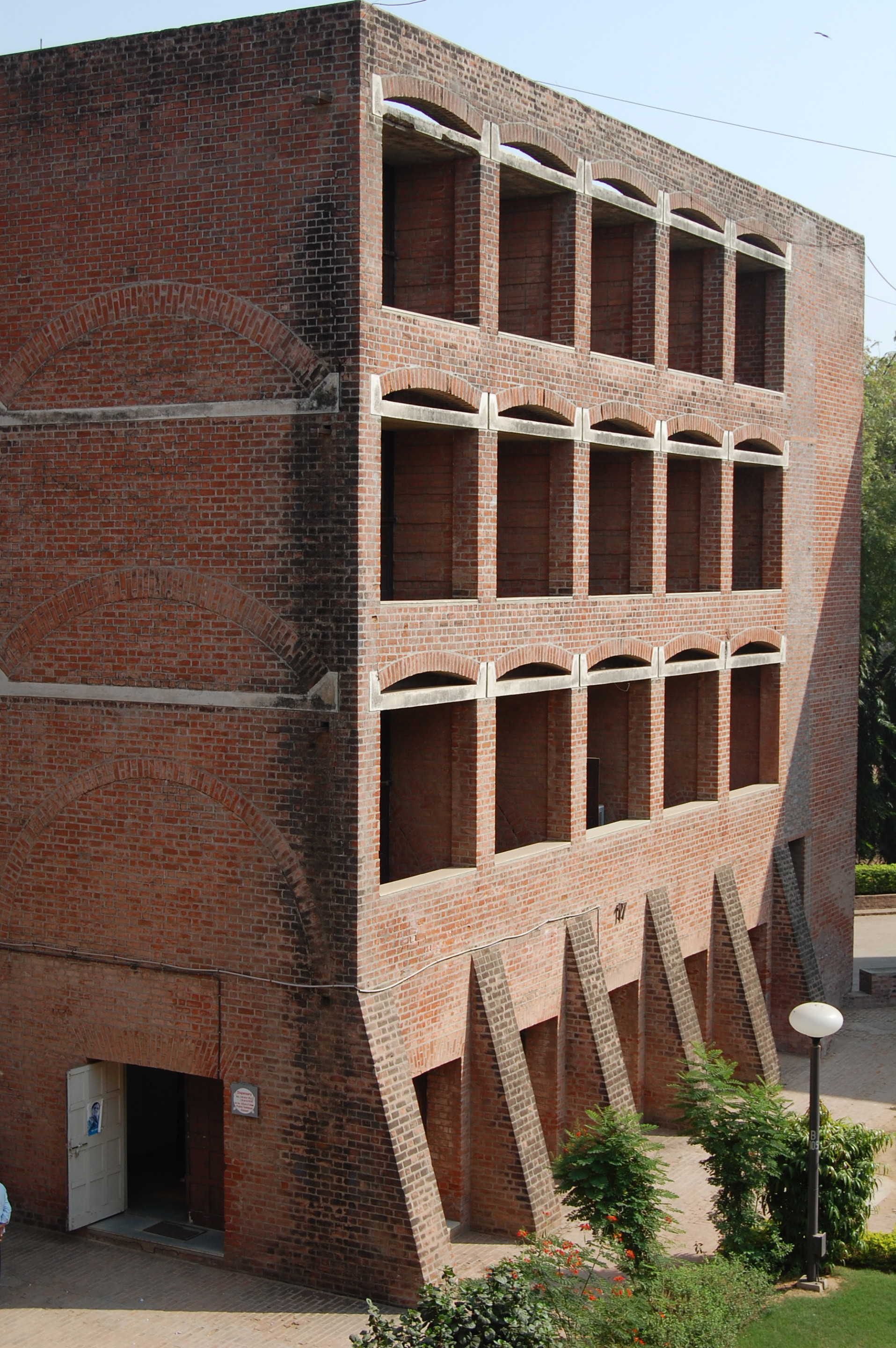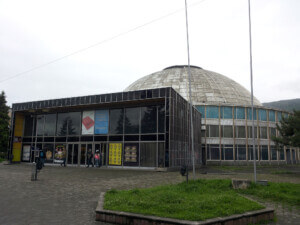[Update: As of January 1, 2021, the school has withdrawn plans to demolish the dorm buildings, citing the international pushback from the architecture community mentioned below]
A week ago, news of the partial demolition of a significant Louis Kahn–designed masterpiece prompted outcry from architects all over the world. Thousands have since signaled their disapproval of a plan to tear down 18 dormitory buildings at the Indian Institute of Management Ahmedabad (IIMA), which, together with the Vikram Sarabhai Library and the main school complex, form the monumental campus.
Many have made direct appeals to IIMA director Errol D’Souza, who, in a December 23 letter addressed to alumni deemed the aging dormitories “unsafe for living in without restoration.” He wrote that a trial renovation of a single dormitory—Dorm 15—had mixed results. Not only had Kahn selected “second-class bricks” for the commission but had used them extensively; nearly two decades after a major earthquake, the bricks are riven with cracks. Moreover, the concrete is spalling, and chunks of the slabs are prone to falling. Even so, he noted that IIM-A had committed to sparing and renovating three additional dormitories, 16-through–18.
D’Souza’s letter coincided with the historian William J. R. Curtis’s report in Architectural Record about IIMA’s decision to demolish the dormitories and to replace them with new buildings. Yet, a letter dated December 22 and signed by Kahn’s three children—Sue Ann Kahn, Alexandra Tyng, and Nathaniel Kahn—expressed “shock and dismay” at the prospect. “The buildings in question are the heart of our father’s universally acknowledged masterpiece at IIMA. We urge you in the strongest possible terms to reconsider this decision,” they wrote.
On December 26th, Vishaan Chakrabarti, dean of the College of Environmental Design at the University of California, appealed directly to D’Souza over Twitter, asking him to reconsider a decision that in any case “cannot be made unilaterally by any institution in an advanced nation,” given the contribution of Kahn’s architecture to the world’s cultural heritage.
Speaking to AN, Chakrabarti called the plans an act of “cultural vandalism.” Moreover, to him, D’Souza’s letter indicated that they were prone to change. “It started with a proposal to tear down 18 dormitory buildings, and now they’ve adjusted it to say they’re only tearing down a few,” he said. “It seems like some of this is just driven by the fact that some of the students want air conditioning and an en-suite bathroom.”

This last comment resonates with a section of D’Souza’s letter in which he rhetorically addresses the lack of amenities among the Kahn dormitories: “With the contemporary user’s need for efficient service how sensitive should we be to the vision of the past and how innovative should we be in order to be in tune with the future? Should the functional requirements of the current user be privileged over the memories of the past?”
The historian Robert McCarter says that natural ventilation was a key element of the campus plan. Not only did it keep down construction and operating costs, but it influenced the experience of walking through the campus.
“What really makes those buildings work is the air that comes through individual rooms and then goes out into the shared space and then is evacuated from the building, so you get constant ventilation,” said McCarter, “which is all the reason they are organized and positioned in the landscape where they are in the masterplans.”
McCarter, who teaches at the Washington University and is the author of a monograph of Kahn’s work, finds the IIMA’s decision baffling. After all, the school has already expended capital to renovate the library, completed in 2014 by the Mumbai-based conservation firm Somaya & Kalappa Consultants (SNK) to much acclaim. (When reached for comment, SNK declined to comment.) He suggests that the success of the previous restoration should give administrators the confidence and know-how to restore the dormitory buildings.
“They’re all built using the same technology—the dormitories, the main buildings, faculty houses, all of which are still in use. It seems like a very strange decision to have come through,” said McCarter. “It’s not just a decision of a couple of academic bureaucrats [who] can do that,” he added, alluding to the absence of arts and design faculty on the IIMA’s governing council.
This is not the first time in recent memory that the fate of a major Kahn work has been questioned. The architect’s Richards Medical Research Laboratories (1965) at the University of Pennsylvania in Philadelphia was designated a National Historic Landmark in 2009 after there were whispers about its possible demolition. The facility underwent a significant renovation and reopened in 2018 with an entirely reworked program.
“When they were first talking about possibly demolishing the [Richards] laboratory building at Penn there was such an uproar that they ran back the other direction as fast as they could,” said McCarter. “It’s not a lab anymore but one of the logics of Kahn’s buildings were that they are timeless, in terms of a certain part of a central space and you can use it for all manner of different functions.”
In their letter, Kahn’s children recount meeting with D’Souza at Richards soon after its reopening. “As you recall, the purpose of the visit to Richards was to see firsthand how a great Kahn building could be reimagined to suit changing needs,” the trio wrote. “We might add that the Richards Building was also at one time in peril of demolition. It is now considered a very useful structure and a desirable address on campus.” At the time, D’Souza promised to keep them in the loop about IIMA’s efforts to renovate the dormitory buildings, whose interiors, they suggest, “could be sensitively reworked to suit alternative needs and uses.”
D’Souza has been outwardly quiet, even as many petition letters have made their way to IIMA’s leadership. (AN has reached out for comment and will update the article accordingly.) The Council on Monuments and Sites, India (ICOMOS) penned a letter to Kumar Mangalam Birla, Chairman of IIMA’s governing council of IIMA, expressing their concerns regarding the plans, while the World Monuments Fund (WMF) has formally called for their wholesale reevaluation. Chakrabarti concluded his own letter to D’Souza with a universal claim: “I’m sure you will agree and seek out an alternative path that is worthy of the international reputation of IIM. The world awaits your reconsideration.”
On December 31, MoMA’s Glenn Lowry and Martino Stierli released a letter that pressed D’Souza to rethink the decision on the basis of the campus’s ingenious placemaking. “Rarely has an architect achieved such a strong sense of place and purpose in a building complex, where spaces for learning are brilliantly interwoven with spaces for dwelling and social interaction,” they wrote. They went on to add that the museum’s next major architectural survey will focus on the modernism of post-independent South Asia. Scheduled to open in early 2022, the exhibition “will bring to the attention of a wide global audience the unique architectural legacy of this period in India, and in the subcontinent more broadly.” Moreover, “[i]t will highlight the IIMA as an unparalleled monument to the integration of campus life and learning, which depends on Kahn’s delicate balance of architecture and space.”
Soon after hearing the news, Sarosh Anklesaria, T. David Fitz-Gibbon Professor of Architecture at Carnegie Mellon University, initiated a petition with an eye toward rallying professionals. In the three days since he and a group of friends began circulating it on Google Docs, the petition has gathered hundreds of signatures from around the world, nearly all of them practicing architects or architectural academics. Pritzker laureates Balkrishna Doshi, Rafael Moneo, and Alejandro Aravena, as well as Tatiana Bilbao, Annabelle Selldorf, and Marlon Blackwell are among the 700 signers and counting.
Anklesaria, who grew up in Ahmedabad, studied architecture at the Centre for Environment Planning & Technology (CEPT), and worked at Sangath, the office of Balkrishna Doshi, is worried that IIMA will be setting a dangerous precedent. “There is no serious movement in India for the conservation of modernist buildings, and if we allow this to happen for Kahn’s buildings to be destroyed, then countless other buildings can be on the chopping block,” said Anklesaria. “There is no stopping after this.”
The IIMA scandal is only the latest in a series of high-profile demolitions. In 2017, Raj Rewal’s visionary Hall of Nations in New Delhi was reduced to rubble after the Delhi High Court dismissed the architect’s plea to preserve it. In 2016 the concrete canteen on CEPT’s campus was unceremoniously razed; the building had been a collaboration between Kurula Varkey, an architect and former director of School of Architecture (CEPT), and Doshi, India’s most well-known architect and a protégé of Le Corbusier and Kahn. It was Doshi who recommended Kahn for the IIMA commission.
“This should serve as a wakeup call for a consolidated concerted effort, especially in South Asia, for the conservation of modernist legacy. We cannot let this become another case like The Hall of Nations.” said Anklesaria. “This should be the start of a massive movement.”











